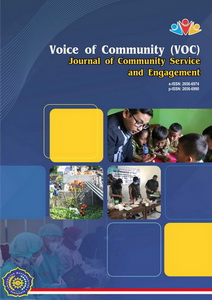Monitoring the Achievement of Environmental Sanitation Indicators at Pulau Kijang Health Center, Indragiri Hilir Regency
DOI:
https://doi.org/10.23917/voc.v5i1.10341Keywords:
Environmental sanitation, Public health, Community-Based Total Sanitation (STBM), Data-driven monitoring, Public participationAbstract
Environmental sanitation is critical for public health as it affects the spread of diseases such as diarrhea, dengue, and respiratory infections. Poor sanitation arises from issues like inadequate access to clean water, insufficient waste disposal systems, and low public awareness. In Indragiri Hilir Regency, despite health programs, issues such as unsafe drinking water, inadequate latrines, and challenges in implementing Community-Based Total Sanitation (STBM) persist. This highlights problems in program execution, including limited resources and community involvement. The community service project was conducted in partnership with Pulau Kijang Health Center. It involved field data collection, interviews, and document review to assess sanitation progress. The monitoring focused on key indicators such as access to safe drinking water, healthy latrines, and waste management. The project concluded with training health staff and local cadres on sanitation evaluation based on data analysis. Initial assessments revealed that previous monitoring efforts were ineffective due to outdated data and a lack of integration. The approach included training for health workers and local cadres on community-based sanitation monitoring, developing a simple digital data recording system, and conducting public education campaigns. The introduction of the digital system improved data organization, and public education campaigns increased community involvement in reporting sanitation issues. Public participation rose significantly, leading to more accurate sanitation data and better monitoring techniques. The program successfully addressed issues such as outdated data and limited human resources through a comprehensive approach. The introduction of digital data systems and community education improved the quality and accessibility of sanitation data. This led to greater community participation and enhanced the capacity of health personnel. The project demonstrates the value of a collaborative, data-driven approach for sustainable improvements in public health and sanitation.
Downloads
References
Ahyanti, M., Yushananta, P., Fikri, A., Usman, S., & Rudiyanti, N. (2023). Peningkatan partisipasi masyarakat dalam mencapai wilayah Sanitasi Total Berbasis Masyarakat di Kecamatan Tanjungkarang Barat Kota Bandar Lampung. Jurnal Kreativitas Pengabdian Kepada Masyarakat (PKM), 6(1), 1–6. https://ejurnalmalahayati.ac.id/index.php/kreativitas/article/view/5566
Astuti, S. M., Erawati, E., Handayani, H., Ruswiyani, R., Setiawan, R. A., & Widiyanto, W. (2024). Pemberdayaan masyarakat dan intervensi kesehatan lingkungan dalam penanggulangan stunting dan penyakit menular. Jurnal Dharma Santi, 8(1), 45–60. https://e-journal.iahn-gdepudja.ac.id/index.php/DS/article/view/2138
Dinas Kesehatan Propinsi Riau. (2023). Profil kesehatan Riau. Dinas Kesehatan Propinsi Riau.
Hidayat, R. (2021). Evaluasi dan monitoring sanitasi lingkungan di Kota X. Jurnal Kesehatan Masyarakat Indonesia, 16(2), 123–134. https://doi.org/10.1234/jkmi.2021.16.2.123
Jamin, F. S., et al. (2024). Pelatihan Edukasi Peningkatan Kesadaran Sanitasi Lingkungan dalam Menghadapi Peningkatan Pemanasan Global. Jurnal Pengabdian kepada Masyarakat Nusantara (JPkMN), 5(1), 1500–1508.https://doi.org/10.55338/jpkmn.v5i1.3010
Mitra, M., Rany, N., Yunita, J., & Nurlisis, N. (2023). Pelatihan kader dalam deteksi dini stunting dan pencegahan stunting melalui pendekatan STBM. J-ABDI: Jurnal Pengabdian kepada Masyarakat, 2(3), 140–147. https://doi.org/10.53625/jabdi.v2i3.2450
Sugiharto, A., Khoe, L. C., Yudanto, R. H., Trianto, D. M., & Muharrom, M. A. (2023). Kelayakan aplikasi mobile untuk pelaporan demam berdarah oleh kader kesehatan masyarakat. Jurnal Teknologi dan Sistem Informasi, 5(2), 112–120. https://jurnal-itsi.org/index.php/jitsi/article/view/192
Susanto, B. (2021). Pengaruh monitoring sanitasi lingkungan terhadap kesehatan masyarakat di Wilayah A. Jurnal Kesehatan dan Lingkungan, 14(4), 345–356. https://doi.org/10.7890/jkl.2021.14.4.345
Utami, N., & Mulyani, S. (2022). Studi kasus evaluasi sanitasi lingkungan pada Puskesmas B. Jurnal Kesehatan dan Sanitasi, 18(2), 98–110. https://doi.org/10.1112/jks.2022.18.2.98
Wahyuni, S., & Fajar, A. (2022). Analisis kebijakan sanitasi lingkungan berbasis data di Daerah Y. Jurnal Ilmu Kesehatan Lingkungan, 19(3), 234 245. https://doi.org/10.5678/jihl.2022.19.3.234
Downloads
Submitted
Accepted
Published
How to Cite
Issue
Section
License
Copyright (c) 2025 kamali zaman, Septiani Winda

This work is licensed under a Creative Commons Attribution 4.0 International License.








